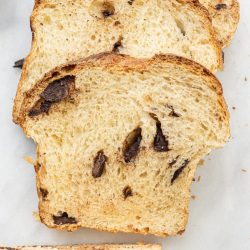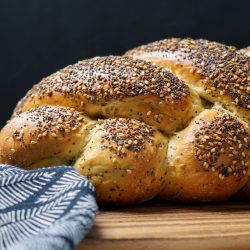A loaf rooted in age-old Jewish tradition and laden with symbolism, the challah we have come to know and love today is a braided soft bread enriched with eggs, oil, and honey that was first made by Ashkenazi Jews in 15th-century Central Europe. The braiding was an adaptation from a local Teutonic solstice bread and its strands—resembling arms intertwined—came to symbolize love as well as truth, peace, creation, freedom, harmony, family connection, unity, and justice. Challah started out as a plain bread that over the course of the 15th century became more enriched. It was not sweetened until the early 19th century, when sugar and other sweeteners, such as honey, became more available and more affordable all over Europe. Sephardic Jews from the Mediterranean and North Africa enriched challah even further by kneading in and garnishing the bread with a customary mix of flavorful spices and seeds. Then as now, challah was used to celebrate the Jewish Sabbath or Shabbat, holidays and important life events.
The religious roots of challah, a word derived from Hebrew, meaning “portion,” extend as far back as the Bible, where, according to Jewish culinary historians, Phyllis and Miriyam Glazer, in The Essential Book of Jewish Festival Cooking, “it refers to the portion of the dough consecrated as a gift for God, and given to the priests of the Temple in Jerusalem before every Sabbath. To this day, traditional Jews consider it a mitzvah* for women, baking bread in the home, to break off a portion of the ready-to-be baked challah dough and throw it into the oven flames, as a way of both reenacting the ancient Temple rights and acknowledging that the bread—all physical sustenance—is ultimately a gift of the divine.”
*This is an honorable task performed to observe a religious commandment.

Challah baked for the Jewish Sabbath and holidays are made in various sizes and shapes, all of which have symbolic meaning. Braided loaves, which may have three, four, five, or six strands, are the most common and grace many a Shabbat table. On the night before the Sabbath, at sundown, a blessing is said over two such loaves, symbolizing, notes Claudia Rodin, author of The Book of Jewish Food, “two portions of the manna that was distributed on Fridays to the children of Israel during their Exodus from Egypt,” so they wouldn’t have to forage for food on the Sabbath. The loaves are covered on the table by a white napkin, which, Rodin further notes, “represents the dew that collected on the manna in the morning. Poppy and sesame seeds sprinkled on the bread also symbolize the manna that fell from heaven.”
For Rosh Hashanah, the Jewish New Year and the first of the High Holidays, the celebratory challah takes the traditional shape of a round turban and is often studded with raisins. The spiral shape, where there is no beginning or end, symbolizes continuity and the circularity of life. The loaves are often sweetened with honey, signifying the wish for a sweet year, richness and good living, and a nod to the Biblical references to Israel as the “land of milk and honey.”

Here at the Bakehouse, we make our challah in the Ashkenazi Jewish tradition with organic wheat flour, fresh cage-free eggs, local Michigan honey from Gearig Apiaries Honey, yeast, and a little corn oil. The flavor is rich, but not too sweet. The texture is soft, but stands up to sandwiches, French toast, and bread pudding. It’s available in gorgeous, toasted saffron-colored braids, per Jewish tradition, or pan loaves we call “squares,” as well as in jumbo sandwich loaves.
During the Jewish High Holidays, starting with Rosh Hashanah, we pull out the stops with two rather fancy celebratory challahs, also rooted in centuries-old Jewish tradition. On order from September 26th through October 8th is our Ashkenazi turban-shaped challah studded with rum-soaked, red flame raisins, together with our more Sephardic-leaning five-strand Moroccan braid, flavored with sesame, poppy, and aromatic anise seeds and brushed with a honey syrup to give it a touch of extra sweetness. Here at the Bakehouse, we often refer to the Jewish High Holidays as “Challah Daze!,” due to all the traditional challahs we make at this time.
By Lee Vedder, Bakehouse Historian
First photo by Antonis Achilleos
After a long, established career as a Ph.D. art history scholar and art museum curator, Lee, a Michigan native, came to the Bakehouse in 2017 eager to pursue her passion for artisanal baking and to apply her love of history, research, writing, and editing in a new exciting arena. Her first turn at the Bakehouse was as a day pastry baker. She then moved on to retail sales in the Bakeshop, followed by joining the Marketing Team and becoming the Bakehouse’s designated culinary historian. In addition to her retail sales and marketing work, she’s a member of the Bakehouse’s Grain Commission, co-author and editor of the Bakehouse's series of cookbooklets, and a regular contributor to the BAKE! Blog and Zingerman’s Newsletter, where she explores the culinary, cultural, and social history and evolution of the Bakehouse’s artisan baked goods.


